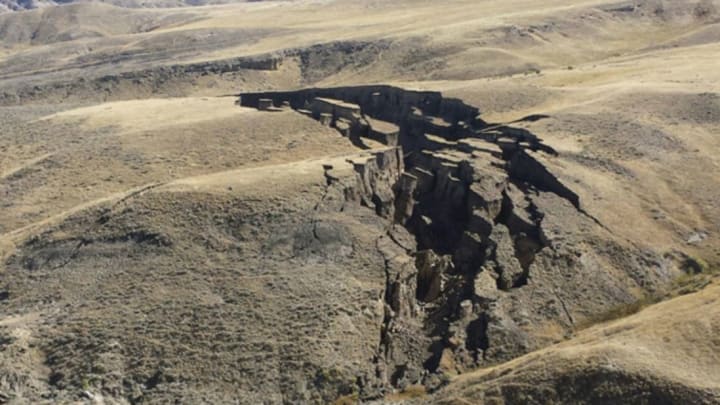A 150-foot-wide chasm has appeared in the foothills of the Bighorn mountain range in Northern Wyoming. Images of the crack were first posted online on October 23 by local hunting outfitters SNS Outfitter & Guides.
This giant crack in the earth appeared in the last two weeks on a ranch we hunt in the Bighorn Mountains. Everyone here is calling it “the gash”. It’s a really incredible sight.Huntwyo.com Posted by SNS Outfitter & Guides on Friday, October 23, 2015
Located 10 miles outside the town of Ten Sleeps, "the gash" stretches for 2250 feet. Although it looks like something formed by an earthquake, no seismic activity has been reported in the area. The crack is more likely a slow-moving landslide produced by an especially rainy spring and summer. Acidic rain or subsurface water can sometimes cause carbonate rocks to dissolve, and variations in underground water flow can also threaten the integrity of sediments supporting the surface layer. These factors can trigger the collapse of the surface soil in a similar way to how sinkholes are formed.
In light of the curiosity surrounding their first post, SNS brought an engineer to investigate the site. On their Facebook page, they posted the follow-up, "Apparently, a wet spring lubricated across a cap rock. Then, a small spring on either side caused the bottom to slide out. He estimated 15 to 20 million yards of movement."
While cap rocks are naturally strong, the rock that lies beneath them can become unstable when infiltrated by high amounts of water. If the cap rock in this case had slipped off, it would have made the weaker rock beneath it vulnerable to rain.
A crack 750 yards x 50 yards appeared in the Bighorn Mountain range, and the pics are crazy https://t.co/OI4luVkEvf pic.twitter.com/T8guY9Bpi7
— Mic (@mic) October 31, 2015
.@aigkenham will use this as "evidence" that the grand canyon was created in a few monthshttps://t.co/3bgkaajHd4 pic.twitter.com/DaPTsk7YdS
— Emery Emery (@emeryemeryii) October 30, 2015
Based on the images, Seth Wittke, Wyoming Geological Survey’s manager of groundwater and geologic hazards and mapping, told the Powell Tribune, "A number of things trigger them, moisture in the subsurface which causes weakness in soil or geology, and any process that would weaken the bedrock or unstabilize it somehow.” Unlike more violent landslides, this one likely occurred at a more gradual pace, according to Wittke.
The survey's public information specialist Chamois Andersen also added, "It is not uncommon to have slides like that." So while unsettling, the crack is thankfully not a sign of seismic catastrophe, as some have feared.
